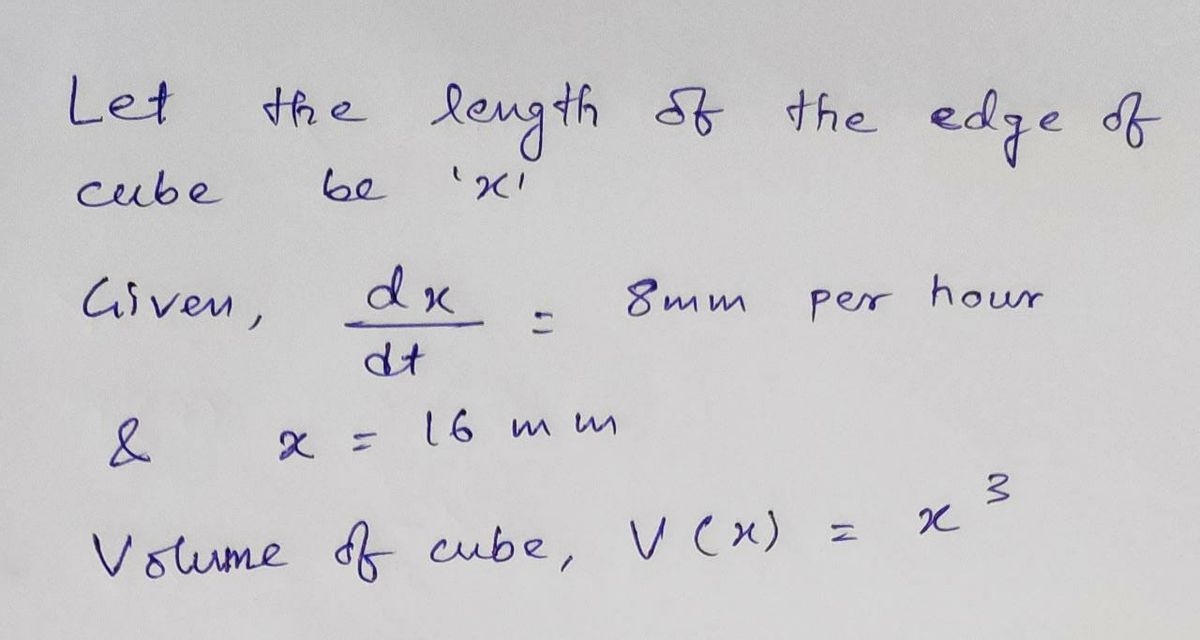Calculus: Early Transcendentals
8th Edition
ISBN:9781285741550
Author:James Stewart
Publisher:James Stewart
Chapter1: Functions And Models
Section: Chapter Questions
Problem 1RCC: (a) What is a function? What are its domain and range? (b) What is the graph of a function? (c) How...
Related questions
Question
Please show your work
![**Problem:**
All edges of a cube are expanding at a rate of 8 mm per hour. At what rate is the volume of the cube changing when each edge is 16 mm?
**Solution:**
To solve this problem, we will use related rates of change in calculus. Let \( x \) be the length of each edge of the cube, and \( V \) be the volume of the cube. The volume of a cube is given by the formula:
\[ V = x^3 \]
To find the rate at which the volume is changing, we need to differentiate \( V \) with respect to time \( t \):
\[ \frac{dV}{dt} = 3x^2 \frac{dx}{dt} \]
Given:
- The rate at which the edge length is increasing: \( \frac{dx}{dt} = 8 \) mm per hour.
- The edge length at the specific time: \( x = 16 \) mm.
Substitute these values into the differentiated equation:
\[ \frac{dV}{dt} = 3(16)^2 (8) \]
Calculate:
\[ \frac{dV}{dt} = 3 \times 256 \times 8 \]
\[ \frac{dV}{dt} = 6144 \]
**Conclusion:**
The volume of the cube is increasing at a rate of 6144 cubic millimeters per hour when each edge is 16 mm.](/v2/_next/image?url=https%3A%2F%2Fcontent.bartleby.com%2Fqna-images%2Fquestion%2Fc777eb6c-5f00-442c-a5ae-30c50b2299ca%2F753df7de-4987-4718-a10b-abdebc0e3ef9%2F3jc6t84_processed.jpeg&w=3840&q=75)
Transcribed Image Text:**Problem:**
All edges of a cube are expanding at a rate of 8 mm per hour. At what rate is the volume of the cube changing when each edge is 16 mm?
**Solution:**
To solve this problem, we will use related rates of change in calculus. Let \( x \) be the length of each edge of the cube, and \( V \) be the volume of the cube. The volume of a cube is given by the formula:
\[ V = x^3 \]
To find the rate at which the volume is changing, we need to differentiate \( V \) with respect to time \( t \):
\[ \frac{dV}{dt} = 3x^2 \frac{dx}{dt} \]
Given:
- The rate at which the edge length is increasing: \( \frac{dx}{dt} = 8 \) mm per hour.
- The edge length at the specific time: \( x = 16 \) mm.
Substitute these values into the differentiated equation:
\[ \frac{dV}{dt} = 3(16)^2 (8) \]
Calculate:
\[ \frac{dV}{dt} = 3 \times 256 \times 8 \]
\[ \frac{dV}{dt} = 6144 \]
**Conclusion:**
The volume of the cube is increasing at a rate of 6144 cubic millimeters per hour when each edge is 16 mm.
Expert Solution
Step 1

Step by step
Solved in 2 steps with 2 images

Knowledge Booster
Learn more about
Need a deep-dive on the concept behind this application? Look no further. Learn more about this topic, calculus and related others by exploring similar questions and additional content below.Recommended textbooks for you

Calculus: Early Transcendentals
Calculus
ISBN:
9781285741550
Author:
James Stewart
Publisher:
Cengage Learning

Thomas' Calculus (14th Edition)
Calculus
ISBN:
9780134438986
Author:
Joel R. Hass, Christopher E. Heil, Maurice D. Weir
Publisher:
PEARSON

Calculus: Early Transcendentals (3rd Edition)
Calculus
ISBN:
9780134763644
Author:
William L. Briggs, Lyle Cochran, Bernard Gillett, Eric Schulz
Publisher:
PEARSON

Calculus: Early Transcendentals
Calculus
ISBN:
9781285741550
Author:
James Stewart
Publisher:
Cengage Learning

Thomas' Calculus (14th Edition)
Calculus
ISBN:
9780134438986
Author:
Joel R. Hass, Christopher E. Heil, Maurice D. Weir
Publisher:
PEARSON

Calculus: Early Transcendentals (3rd Edition)
Calculus
ISBN:
9780134763644
Author:
William L. Briggs, Lyle Cochran, Bernard Gillett, Eric Schulz
Publisher:
PEARSON

Calculus: Early Transcendentals
Calculus
ISBN:
9781319050740
Author:
Jon Rogawski, Colin Adams, Robert Franzosa
Publisher:
W. H. Freeman


Calculus: Early Transcendental Functions
Calculus
ISBN:
9781337552516
Author:
Ron Larson, Bruce H. Edwards
Publisher:
Cengage Learning